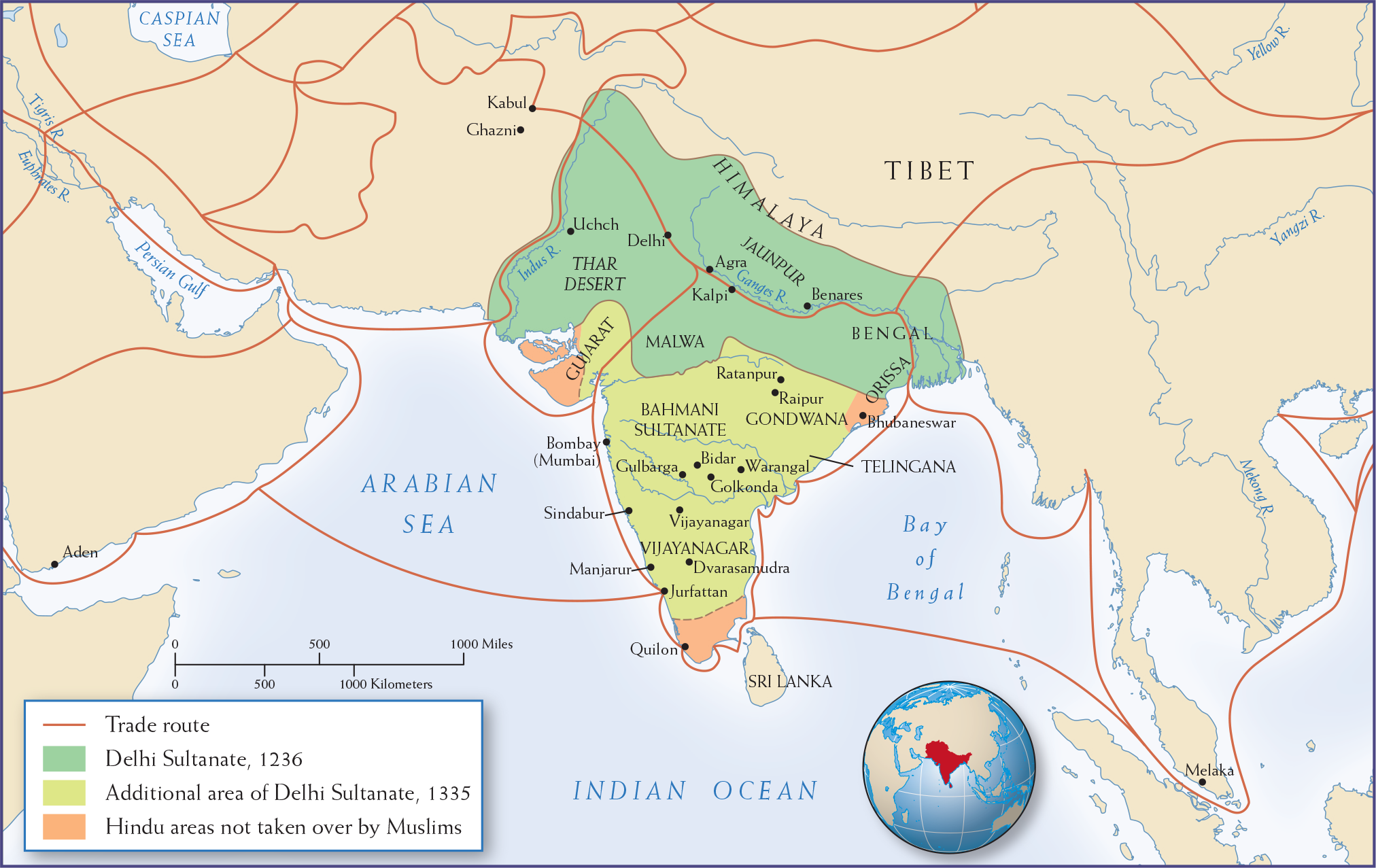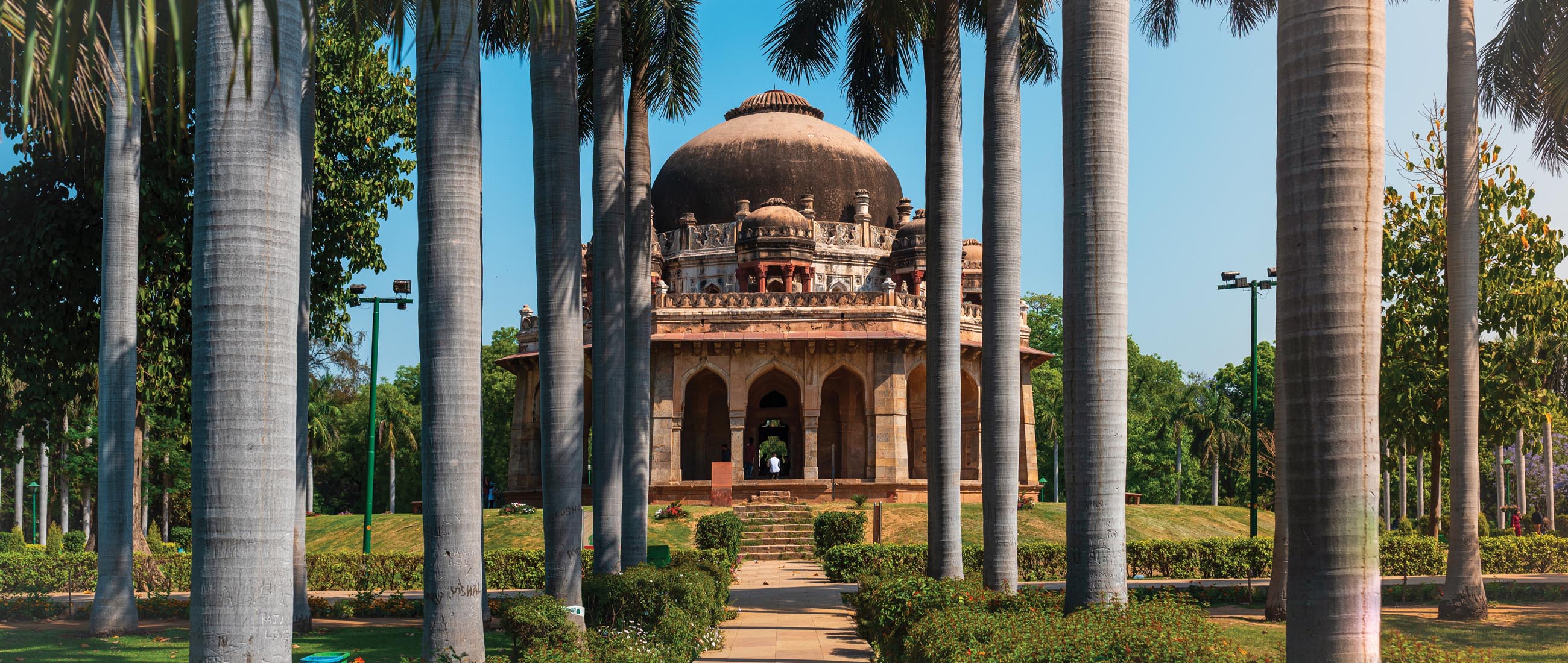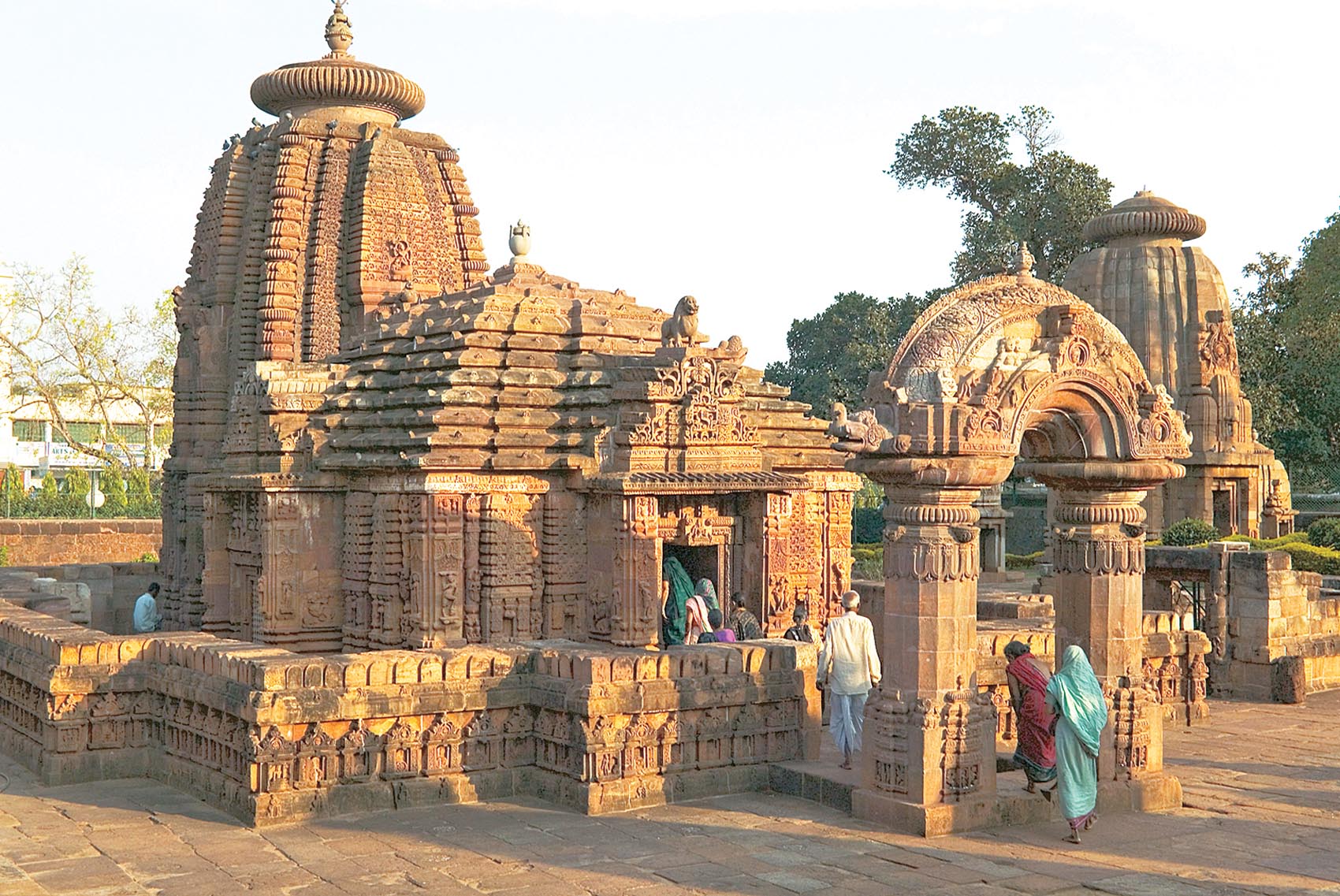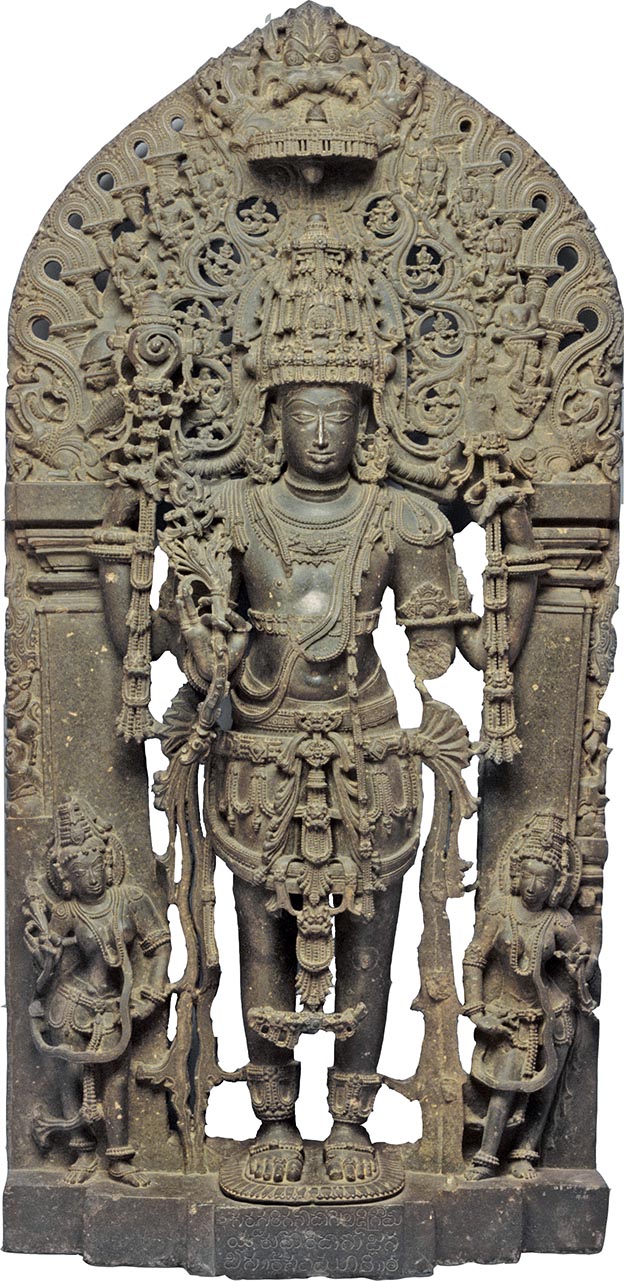India as a Cultural Mosaic
With its pivotal location along land- and sea-based trade routes, India became an intersection for the trade, migration, and culture of Afro-Eurasian peoples. With 80 million inhabitants in 1000 CE, it had the second-largest population in the region, just behind China’s 120 million. Turks ultimately spilled into India as they had into the Islamic heartlands, bringing their newfound Islamic beliefs. But the Turkish newcomers encountered an ethnic and religious mix of which they composed only one part. (See Map 10.3.)

More information
Map 10.3 is titled South Asia in 1300. The map shows the Delhi Sultanate in 1236 and its additional areas in 1335, as well as trade routes and Hindu areas not taken over by Muslims. The Delhi Sultanate controlled the northern region of present-day India in 1236 between the Malwa, Thar Desert, Himalaya, and Bengal regions. The additional area in 1335 moves south to include the Bahmani Sultanate, Gondwana, and Vijayanagar. The small pockets of Hindu areas not taken over by Muslims are located on the very tip of southern India, as well as a small pocket on the west coast in Gujarat and on the east coast around the city of Bhubaneswar. Trade routes travel across Southwest Asia, Tibet, India, the Arabian Sea, the Bay of Bengal, and East Asia.
MAP 10.3 | South Asia in 1300
As the fourteenth century began, India was a blend of many cultures. Politically, the Turkish Muslim regime of the Delhi Sultanate dominated the region.
- What region was controlled by the Delhi Sultanate in 1236? How did the area controlled by the Delhi Sultanate change in 100 years?
- How does the map suggest that trade routes helped spread the Muslims’ influence in India?
- Where on the map do Hindu areas resist Muslim political control? Based on your reading, what factors may have accounted for Hinduism’s continued appeal despite the Muslims’ political power?
Before the Turks arrived, India had been splintered among rival chiefs called rajas. These leaders gained support from Brahmans by doling out land grants to them. Since much of the land was uncultivated, the Brahmans first built temples, then converted the indigenous hunting and gathering peoples to the Hindu traditions, and finally taught the converts how to cultivate the land. In this way the Brahmans simultaneously spread their faith and expanded the agrarian tax base for themselves and the rajas. They also repaid the rajas’ support by compiling elaborate genealogies for them and endowing them with legitimizing ancestries. In return, the rajas demonstrated that they, too, were well versed in Sanskrit culture, including equestrian skills and courtly etiquette, and were prepared to patronize artists and poets.
Invasions and Consolidations
When the Turkish warlords began entering India, the rajas had neither the will nor the resources to resist them after centuries of fighting off invaders. For example, Mahmud of Ghazna (r. 998–1030 CE) launched many expeditions from the Afghan heartland into northern India and, eager to win status within Islam, made his capital, Ghazna, a center of Islamic learning. Mahmud’s expansion in the early eleventh century marked the height of what came to be known as the Ghaznavid Empire (977–1186 CE). Later, in the 1180s, Muhammad Ghuri led another wave of Islamic Turkish invasions from Afghanistan across the Delhi region in northern India. Wars raged between the Indus and Ganges Rivers until, one by one, all the way to the lower Ganges Valley, the fractured kingdoms of the rajas toppled. The Turks introduced their own customs while accepting local social structures, such as the hierarchical varna system. The Turks constructed grand mosques and built impressive libraries where scholars could toil and share their wisdom with the court.

More information
An Islamic tomb at Lodi Gardens. The tomb is located at the center beyond a landscaped garden. The tomb is comprised of a large dome with several smaller domes surrounding it, supported by a circle of arches. The garden has a stone path, grass, bushes, and many palm trees.
While the Ghaznavids were impressive, the most powerful and enduring of the Turkish Muslim regimes of northern India was the Delhi Sultanate (1206–1526). Its rulers brought political integration to their territory but also strengthened the cultural diversity and tolerance that were already a hallmark of the Indian social order. Sultans recruited local artisans for building projects, and palaces and mosques became displays of the Indian architectural tastes adopted by Turkish newcomers. But Islam never fully dominated South Asia because the sultans did not forcibly convert their subjects. Nor did they display much interest in the flourishing commercial life along the Indian coast. The sultans permitted these areas to develop on their own: Persian Zoroastrian traders settled on the coast around modern-day Mumbai, while farther south, Arab traders controlled the Malabar coast.

More information
A photo of a Hindu temple in India. The central room has a tall domed ceiling. There is another taller dome behind the central dome. The entrance to the temple is a large stone arch that people are seen walking under.
Expanding India
During the eleventh, twelfth, and thirteenth centuries, India became the most diverse and, in some respects, most tolerant region in Afro-Eurasia. India in this era arose as an impressive but fragile mosaic of cultures, religions, and ethnicities.
When the Turks arrived, the local Hindu population, having had much experience with foreign invaders and immigrants, assimilated these intruders as they had done earlier peoples. Before long, the newcomers thought of themselves as Indians who, however, retained their Islamic beliefs and steppe ways. They continued to wear their distinctive trousers and robes and flaunted their horse-riding skills. At the same time, the local population embraced some of their conquerors’ ways, donning the tunics and trousers that characterized central Asian peoples.
Diversity and cultural mixing became most discernible in the multiple languages that flourished in India. Although the sultans spoke Turkish languages, they regarded Persian literature as a high cultural achievement and made Persian their courtly and administrative language. Meanwhile, most of their Hindu subjects spoke local languages, adhered to the regulations of the varna system of hierarchies, and practiced diverse forms of Hindu worship. The rulers in India did what Muslim rulers in Southwest Asia and the Mediterranean did with Christian and Jewish communities living in their midst: they collected the jizya tax and permitted communities to worship as they saw fit and to administer their own communal law.

More information
A sandstone sculpture of the four-armed Vishnu. Vishnu holds four attributes in his four hands. Two smaller humanoid figures are displayed at the feet of the sculpture. An arch of ornate carvings stretches out above Vishnu.
Ultimately, Islam proved in India that it did not have to be an intolerant conquering religion to prosper. Although Buddhism had been in decline there for centuries, it, too, became part of the cultural intermixing of these centuries. As Vedic Brahmanism evolved into Hinduism (see Chapter 8), it absorbed many Buddhist doctrines and practices, such as nonviolence (ahimsa) and vegetarianism. The two religions became so similar in India that Hindus simply considered the Buddha to be one of their deities—an incarnation of the great god Vishnu. Many Buddhist moral teachings mixed with and became Hindu stories. Artistic motifs reflected a similar process of adoption and adaptation. Goddesses, some beautiful and others fierce, appeared alongside Buddhas, Vishnus, and Shivas as their consorts. The Turkish invaders’ destruction of major monasteries in the thirteenth century deprived Buddhism of local spiritual leaders. Lacking a political regime to support them, Buddhists in India were more easily assimilated into the Hindu population or converted to Islam.
Once the initial disruptive effects of the Turkish invasions were absorbed, India remained a highly diverse and tolerant region during this period. Most importantly, India emerged as one of the world’s four major cultural spheres, enjoying tremendous levels of integration as Turkish-Muslim rulers, and their traditions and practices, successfully mixed with native Hindu society, leading to a more integrated and peaceful India.
Glossary
- Delhi Sultanate (1206–1526)
- A Turkish Muslim regime in northern India that, through its tolerance for cultural diversity, brought political integration without enforcing cultural homogeneity.